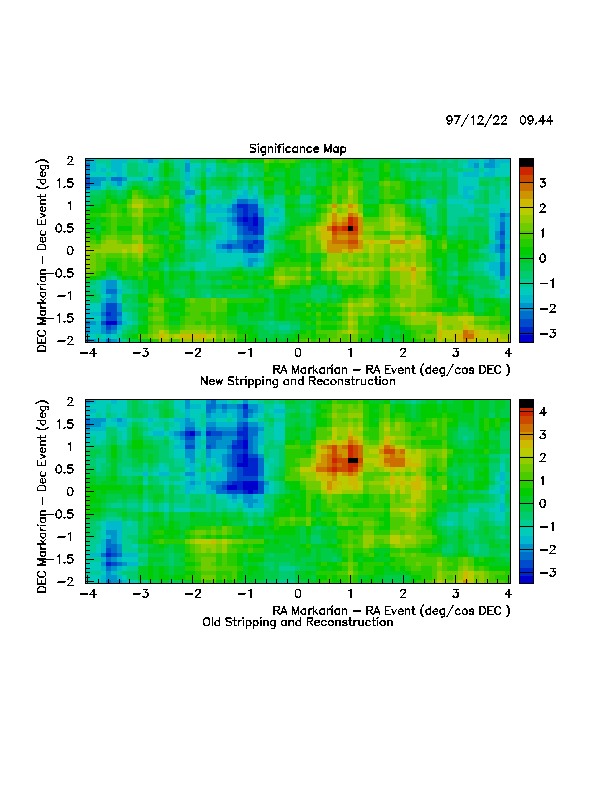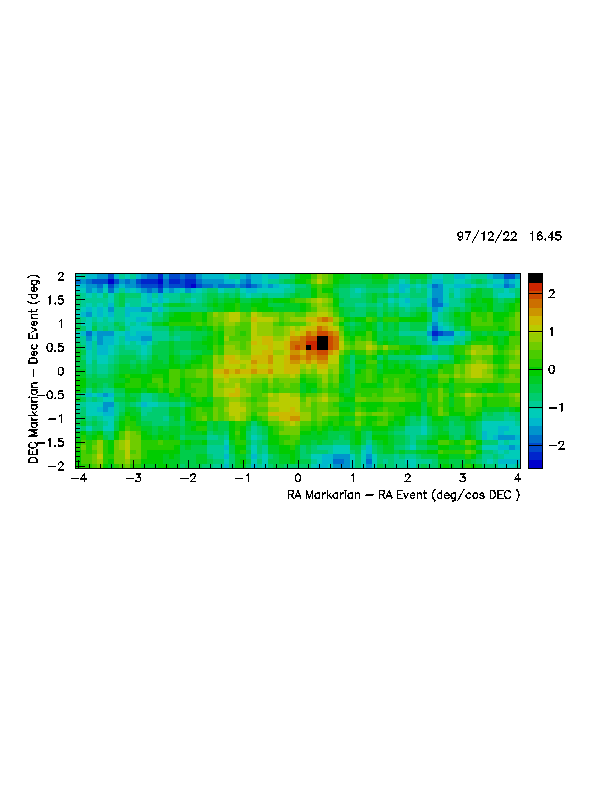
This memo is an update for the collaboration of the stripping,
reconstruction
and analysis of the Markarian 501 data. I will
present here a description
of the stripping method and describe the reconstruction
and analysis
performed to date.
Stripping:
The process of removing the subset of raw Milagrito data
required for a
Markarian 501 analysis is what I call "stripping". This
was done as follows:
1) The Milagrito raw data tapes were loaded into the tape
library and
read in their entirety. Events
collected at times in which the zenith
RA was within +/- 80 deg of
the Markarian 501 RA were retained.
2) For runs in which there was no online reconstruction,
all retained
events were reconstructed offline.
Events with declinations within
+/- 15 deg of the Markarian
501 DEC were stripped.
3) For runs where the data was processed online, events
with a declination
within +/-25 deg of Markarian
501 were reconstructed offline. If
the offline reconstruction yields
a declination within +/- 15 deg of
Markarian 501, then the event
is stripped.
4) About 15% of all events are stripped from the raw data with this method.
To date, data tapes 1-124 have been stripped. Three tapes
were either partially
read or skipped due to tape read errors. My expectation
is that these tapes are
mostly recoverable. Two tapes were written with a data
format not compatable
with the current version of DataRead. These tapes should
be easy to recover
with modifications to the software.This subset includes
data from the turn on
date (Feb 8) to Jun 19. This is about 60% of the data
that I was authorized
to analize at the Maryland collaboration meeting.
The stripped data consumes about 250 Gb of data and has
been saved to
8 high density DLT tapes.
Reconstruction:
The stripped data were reconstructed using the standard
offline ChiSq
angle fitter. A curvature correction of 4ns/100m was
applied in the plane
of the pond with the standard offline function Curve.c.
The processed
data was saved to disk and resides at /cosmo/mrk501/proc/proc.
Feel
free to analize the data with your favoirite time sloshing
program.
As the stripping process was systematic, I restripped
8 of the 10 days
from the previous Markarian data set. I can use these
twice stripped days
as a test stripping and reconstruction processes.
Analysis:
I used the same program to analize these data as was presented
at the
Maryland collaboration meeting. It is a "standard" time
sloshing method
ala the NIM article published by a subset of the Cygnus
collaboration.
Presented below are significance plots of the 8 overlaping
days for the new
and old processed data sets. Both were reconstructed
with a 4ns/100m
curvatrure correction. Events are considered with
theta<45 deg and number
of tubes in the fit greater than 40. The total bin size
is 1.5 deg.
The RA dimension has been compacted so that the bins
are square in the
local coordinate system. Both plots show a maximum near
RA:+1.0 "deg"
and DEC:+0.6 deg. There have been some minor changes
to the offline code
since the old data was reconstructed, but qualitatively,
the plots are nearly
identical.

With the 8 overlapping days subtracted and the hypothosis
that there is a souce at
the posistion identified in the above plots, I then analized
the independant
data set. The entire data set excluding the 8 overlaping
days contains about
70 days of integrated exposure. The significance plot
for the 70 days is shown
below.
This result is hardly difinitive or compelling. It is
interesting to note that for a
larger bin size (2.3 deg total bin size) the resulting
significance map is
proc9.ps

Plans:
The plan is simple. I must complete the stripping process,
before any definitive
conclusions should be drawn. It should take about 3 weeks
finish the stripping.
Stay tuned.